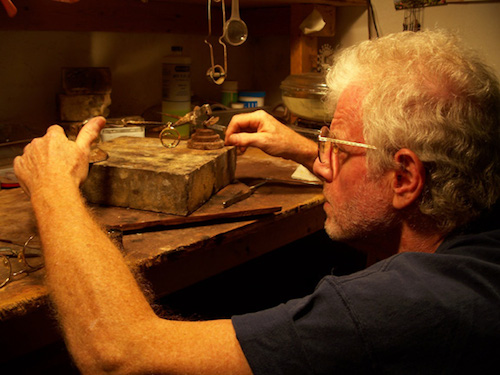
Lee was born and raised in Chicago, Illinois. His career as a jeweler began at Indiana University, Bloomington, Indiana. There he was educated in jewelry design and silver smithing by Alma Eikerman. He apprenticed with Douglas Steakley. This association led to his employment at Argentum Jewelry, Bloomington, Indiana. Lee continues to exhibit his work both locally and nationally in galleries and at juried art fairs throughout the Midwest and Florida.
Since its inception in 1979, he is a charter member and co-owner of the By Hand Gallery, Bloomington, Indiana.
Artist Statement
In 1971, after my 3rd year of medical school studying to be a neurosurgeon, I decided it wasn’t challenging enough and chose to become an artist. This calling enables me to attain spiritual wisdom, pursue autonomy and humbly nurture myself, solely from my artistry. Through my work I leave my legacy and find redemption. I am hopeful to exalt the spirit, to thereby promote healing of the mind, body and soul. To therein enrich the quality of “the moment” for the observer and myself.
My creations emphasize the 3-dimensional interplay of lines, planes and the negative (empty) spaces they define. Their fluidity and simplicity lend to elicit grace, energy and the dynamic movement of forms flowing together or in opposition to one another, clastic and anti-clastic. Materials of choice include 14k, 18k gold and sterling silver. Gemstones may be juxtaposed as accents of shape and color to further enhance, compliment and contrast the configuration of each piece. I design, create and sign all my work. Save God, I am unassisted in my studio.
Technical Statement
All of the jewelry, hollow ware and mobiles are constructed (not cast) by soldering together several individually smithed (hammered/forged) components that originate from varying thicknesses of round wire and sheet stock. The hollow ware cups are “raised” from flat round discs. Various types of pliers, hammers and anvils are employed to achieve the desired shapes and textures.
Each piece is meticulously finished. The process begins with a file, followed by sanding out the scratches with a fine grit abrasive paper. Then, a very fine abrasive compound is applied to different types of buffing wheels. Finally, that same abrasive is employed with string. The string enables one to reach the deeply recessed surfaces that are inaccessible by any of the other means. The string is much like using a “one hair” paint brush on a painting. It is intricate and exacting. The final polishing is also completed with the buffs and string.
